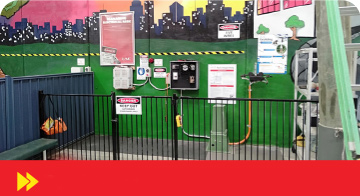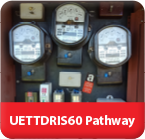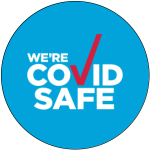
INTRODUCTION
A contestable works program exists under the NSW Electricity Supply Act 1995. This provides electricity customers in NSW with the right to choose suitably qualified and accredited persons to connect their premises to the Network Operator’s distribution network, arrange for the supply of more electricity from the distribution network than they are currently consuming, or to extend the distribution network to reach their premises.
To ensure that the electrical distribution network and connection to the distribution network remains reliable and safe, only Accredited Service Providers (ASPs) operating under the ASP scheme administered by NSW Trade & Investment, may perform this work.
Employees and sub-contractors of ASPs must be suitably qualified and registered with the ASP scheme before seeking authorisation from the local Network Operator to work on or near the electricity network.

ASP LEVELS
The ASP Scheme accredits different types (levels) of work.
LEVEL 1 ACCREDITATION
allows for both overhead and underground construction work on distribution networks which are located adjacent to roadway. Level 1 service providers may be accredited for the following work categories:
- overhead lines
- underground lines.
LEVEL 2 ACCREDITATION
allows for construction of service lines between the distribution system and the point of connection to the premises and for the installation and energisation of metering services. Level 2 service providers may be accredited for the following work categories:
- disconnection and reconnection
- underground service lines
- overhead service lines
- metering and energising new installations
- installing contestable market metering
LEVEL 3 ACCREDITATION
allows for the design of distribution networks. Service providers may be accredited for the following work categories:
- overhead lines
- underground lines.
level 2 qualifications
The services that can be undertaken by a Level 2 ASP are as follows (but not limited to):
Class 2A
(previously known as Category 1) – Disconnect and reconnect.
- Disconnection and reconnection of service lines at the connection point – but only work at the connection point that does not involve accessing network operator assets and no mechanical changes to network assets are required.
Class 2B
(previously known as Category 2) – Work on underground service conductors. For example:
- remove and replace a local electricity distributor security seal in accordance with local electricity distributor procedures;
- installation and connection of underground service lines in accordance with the NSW Service & Installation Rules;
- relocate/upgrade an existing underground service line and restore supply on completion;
- disconnection and reconnection of underground service lines at the point of common coupling and the connection point; and
- replacement of service protection device and meter protection device fuse(s), service active and neutral links
Class 2C
(previously known as Category 3) – Work on overhead service conductors. For example:
- remove and replace a local electricity distributor security seal in accordance with local electricity distributor procedures;
- installation and connection of overhead service lines in accordance with the Service & Installation Rules of NSW;
- relocate/upgrade an existing overhead service line and restore supply on completion;
- disconnection and reconnection of overhead service lines at the point of common coupling and the connection point; and
- replacement of service protection device and meter protection device fuse(s), service active and neutral links.
Class 2D
(previously known as Category 4) – Installing metering for meter types 5 to 6 and other Network Operator service equipment:
- remove and replace a local electricity distributor security seal in accordance with local electricity distributor procedures;
- installation and removal of whole current metering equipment in accordance with the local distributor’s published standards; and
- disconnection and reconnection of the installation at the connection point; and
- energising new installations.
An ASP may only remove or install meters of types 1 to 4 if the ASP is also accredited as a meter provider with the Australian Energy Market Operator (AEMO) or the ASP is undertaking this work as a sub-contractor to another company which is properly accredited by AEMO for this purpose.
Class 2X
Non-electrically qualified. This class allows non-electrically qualified personnel to be registered with the ASP Scheme in accordance with the Scheme Rules. It also allows application to be made to a distributor for authorisations not covered in the Scheme Rules, where the requirements for those authorisations are set by the Distributors. Examples of specific authorisations that may be required by a distributor include:
- electrical trade related works performed by electrical trades apprentices covered by a training contract that may be required to work on or near the network under direct and constant supervision of an appropriately authorised person,
- work performed by persons engaged by a telecommunications network operator on telecommunications assets attached to electricity network operator assets,
- trades assistant work such as safety observer, rescue assistant and plant operator.
Level 2 Training and Assessment requirements

| Level 2 ASP Qualification and training requirements | |||
|---|---|---|---|
| Classes of Contestable Services (type of work) |
ASP Scheme Qualification Criterion for Level 2 ASPs Training organisations must be registered with Australian Skills Quality Authority or their state training authority and must have the relevant qualification and unit of competency on their scope of registration to deliver training and/or assessment. |
||
| Core Qualifications (refer Note 1) | Additional Mandatory Competency Units (refer Note 2) | ||
|
Class 2A _ Disconnect and reconnect at connection point |
Meet requirements for class 2B or 2C OR Curently registered for Disconnect / reconnect (former Level 2 Category 1) |
UETTDREL16 - Working safely near live electrical apparatus AND UETTDRRF11 - Testing of connections to low voltage electricity networks |
|
|
Class 2B _ Underground Services (previous Category 2) |
UEE30811 - Certificate III in Electro-technology Electrician (or equivalent) OR UET30812 - Certificate III in ESI - Power Systems - Distribution Cable Jointing |
UETTDRIS55 - Install and maintain low voltage underground services AND UETTDRRF11 - Testing of connections to low voltage electricity networks, |
|
|
Class 2C _ Overhead Services (previous Category 3) |
UEE30811 - Certificate III in Electrotechnology Electrician (or equivalent) OR UET30612 - Certificate III in ESI - Power Systems - Distribution Overehad |
UETTDRIS56 - Install and maintain low voltage overhead services AND UETTDRRF11 - Testing of connections to low voltage electricity networks, |
|
|
Class 2D _ Metering & Energisind Installations - including disconnect and reconnect (previous Category 4) |
UEE30811 - Certificate III in Electro-technology Electrician (or equivalent) |
UETTDREL16 - Working safely near live electrical apparatus AND UEENEEK142A - Apply enviromentally and suistainable energy procedures in the energy sector AND either
UETTDRRF11 - Testing of connections to low voltage electricity networks |
|
|
Note 1: Upon verification; those holidng an equivalent qualification to
Registered Training Organisations (RTO's) must ensure that any/all prerequisite units of competency (as specified within each of the relevant competency standards) have been achieved prior to awarding any of the units of competency specified within "Additional Mandatory Competency Units" column of Level 2 table. |
|||
Transitional arrangements
(a) All existing Level 2 ASPs and personnel registered before December 31st 2015 will continue to have their training recognised as before and to hold the relevant categories of registration.
(b) From December 31st 2015, any evidence of training which complies with the table above will be accepted as part of an application for registration.
(c) Until 31 December 2015, the scheme administrator will accept training certificates issued under the previous method used to train Level 2 ASPs as part of an application for registration. This will allow RTOs to transition to the new training requirements and allow individuals to complete their training and submit an application in a timely manner.
(d) From 1 January 2016, only training which complies with Appendix B will be accepted as part of an application for registration unless an individual has been registered previously as per (a) above.
CATEGORY 2 UNDERGROUND
TRAINING AND ASSESSMENT

UETTDRIS55
Install and maintain low voltage underground services
Unit Descriptor: This Competency Standard Unit covers the installation, maintenance and connection of low voltage underground service lines and associated equipment (between the connection point and the point of supply - customers’ premises). Maintenance includes the repair and replacement of service cables, service fuses and the replacement and repair of service hardware, the identification and rectification of faults. It also covers insulation, voltage, polarity testing and phase rotation.
Learning Outcomes:
At the completion of this Unit of Competency, you should be able to:
1. Prepare for the installation and maintenance of LV underground services and associated equipment
2. Carry out installation and maintenance of LV underground services and associated equipment
3. Complete the installation and maintenance of LV underground services and associated equipment.
Prerequisite Unit(s) Competencies: Granting of competency in this unit shall be made only after competencies in the Common Unit Group have been completed plus all the competencies in one (1) of the identified Pathway Unit Group(s): Transmission Overhead, Distribution Overhead, Rail Traction, Distribution Cable Jointing, Electrotechnology Electrician (Refer to Pathway over).
Scheduling: The delivery duration is approximately 2 days or as required.
CATEGORY 3 OVERHEAD
TRAINING AND ASSESSMENT

UETTDRIS56
Install and maintain low voltage overhead services
This Competency Standard Unit covers the installation, maintenance and connection of low voltage overhead service lines and associated equipment (between the connection point and the point of supply - customers’ premises). Maintenance includes the repair and replacement of service cables, service fuses and the replacement and repair of service hardware, the identification and rectification of faults. It also covers insulation, voltage, polarity testing and phase rotation.
Learning Outcomes:
At the completion of this Unit of Competency, you should be able to:
1. Prepare for the installation and maintenance of LV overhead services and associated equipment
2. Carry out installation and maintenance of LV overhead services and associated equipment
3. Complete the installation and maintenance of LV overhead services and associated equipment
Prerequisite Unit(s) Competencies: Granting of competency in this unit shall be made only after competency in the following unit(s) has/have been confirmed. Where pre-requisite pathways have been identified. All competencies in the Common Unit Group must be have been completed plus all the competencies in one (1) of the identified Pathway Unit Group(s): Transmission Overhead, Distribution Overhead, Rail Traction, Distribution Cable Jointing, Electrotechnology Electrician.
Scheduling: The delivery duration is approximately 4 days or as required.
CATEGORY 4 METERING &
ENERGISING INSTALLATIONS
TRAINING AND ASSESSMENT

UETTDRIS60
Install and replace power system energy meters and associated equipment
This Competency Standard Unit covers the installation and replacement of whole current energy meters and associated equipment, where replacement may include the identification of faults in accordance with established procedures and return to service. It includes the requirements to ascertain if normal functions of the meters and associated equipment are in accordance with established procedures.
Learning Outcomes:
At the completion of this Unit of Competency, you should be able to:
1. Prepare for the installation and replacement of energy meters and associated equipment
2. Carry out the installation and replacement of energy meters and associated equipment
3. Complete the installation and replacement of energy meters and associated equipment
Prerequisite Unit(s) Competencies: Granting of competency in this unit shall be made only after competency in the following unit(s) has/have been confirmed. Where pre-requisite pathways have been identified. All competencies in the Common Unit Group must be have been completed plus all the competencies in one (1) of the identified Pathway Unit Group(s): Distribution Overhead, Distribution Cable Jointing, Electrotechnology Electrician.
Scheduling: The duration of this unit of competency is approximately 4 days or as required.
Electrotechnology (Electrician’s pathway) Recognition
RTOs are obligated to recognise training and assessing that you have already undertaken, so you don’t need to undertake it again.
* UEENEEG105A Extract states that ‘Those holding an ‘Unrestricted Electrician’s Licence’ or equivalent issued in an Australian State or Territory meet the requirements of this unit and its pre-requisite requirements. A ‘licensed electrician’ applying for an ‘electrical contractors licence’ may be required to undertake this unit to demonstrate their currency with verification of compliance requirements. In this case they are deemed to have met the pre-requisites for this unit provided that they hold a current ‘electricians licence’ or its equivalent issued in an Australian State of Territory and have recently been in permanent employment as a licensed electrician sufficient to evidence current knowledge of applicable standards and regulations’.
Note: Electrician’s must still be subject to the recognition process for this to occur.
| Electrotechnology Electrician Pathway Group | |
|---|---|
| Unit Code | Unit Title |
| UEENEEE137A | Document and apply measures to control OHS risks associated with electrotechnology work |
| UEENEEG006A | Solve problems in single and three phase low voltage machines |
| UEENEEG033A | Solve problems in single and three phase electrical apparatur and circuits |
| UEENEEG063A | Arrange circuits, control and protection for general electrical installations |
| UEENEEG106A | Terminate cables, cords and accessories for low voltage circuits |
| UEENEEG108A | Trouble-shoot and repair faults in low voltage electrical apparatus and circuits |
| UEENEEG109A | Develop and connect electrical control circuits |
| UEENEEK142A | Apply enviromentally and sustainable energy procedures in the energy sector |
| UETTDRIS67 | Solve problems in energy supply network equipment |
| Common Unit Group | |
|---|---|
| Unit Code | Unit Title |
| UEENEEE101A | Apply Ocupational Health and Safety regulations, codes and practices in the workplace |
| UEENEEE102A | Fabricate, assemble and dismantle utilities industry cmponents |
| UEENEEE104A | Solve problems in d.c. Circuits |
| UEENEEE105A | Fix and secure electrotechnology equipment |
| UEENEEE107A | Use drawings, diagrams, schedules, standards, codes and specifications |
| UEENEEG101A | Solve problems in electromagnetic devices and related circuits |
| UEENEEG102A | Solve problems in low voltage a.c. Circuits |
| UETTDREL16 | Working safely near live electrical apparatus |
| ACCREDITATION | AUTHORISATION |
|---|---|
|
To become accredited an applicant must apply in writing, using the |
Following registration, an ASP must seek to have those personnel |
Statutory Training also required
Everybody who works on or near the Electricity Supply Network must be deemed competent in the tasks they are to perform; and trained and assessed yearly in the appropriate escape, release and rescue procedures for those tasks.
ASP Annual Refresher Training |
Level 2 ASPs | Civil | |||
|---|---|---|---|---|---|

* for cable jointing work from an EWP no poles > 2m above ground level and from EWPs + for live cable jointing work in a trench enviroment |
Unit of Competency | Class 2D | Class 2B | Class 2C | Class 2X |
|
HLTAID001 Provide Cardio Pulmonary Resuscitation |
✔ | ✔ | ✔ | ✔ | |
|
UETTDRRF02B
Perform pole top rescue |
✔ | ✔ | |||
|
UETTDRRF03B Perform EWP rescue |
✔ | ||||
|
UETTDRRF06B
Perform rescue from a live LV panel |
✔ | ✔ | ✔ | ✔ | |
|
UETTDRRF08B
Perform EWP controlled descent escape |
✔ | ||||
|
UETTDRRF10B Provide first aid in an ESI enviroment |
✔ | ✔ | ✔ | ✔ | |
|
UETTDRRF11 Testing of connections to low voltage electricity networks |
✔ | ✔ | ✔ | ||
 www.iacsafetyservices.com.au
or
www.iacsafetyservices.com.au
or
|
|||||
Important: Statutory Training is not included in the specific Category Accreditation training and must be undertaken separately.
This is due to the fact, that many students will have already undertaken these studies especially if they are current ASPs upgrading their accreditations; each students will have different requirements associated with their accreditation; finally and perhaps more importantly, the ASP initial training and assessment study schedule is intensive and time restrictions and workloads simply would not allow for this training to happen in the time frames allocated.
VENUES

Blacktown
Unit 1 / 39-41 Fourth Ave Blacktown NSW 2148

Thornton
Lot 8 / 13 Hartley Drive Thornton NSW 2322 (Near Newcastle)
TIME

07:30
to 15:30
every day.
Note: THese times are
subjected to vary.
Students
please note:
Classes start
ON TIME
07:45
Onward
No Student
Admittance.
No Exception.

DURATION
| Class Schedule | |||||
|---|---|---|---|---|---|
| Monday | Tuesday | Wednesday | Thursday | Friday | |
| Metering | Blacktown | Blacktown | |||
| Overhead | Blacktown | Thornton | Thornton | ||
| Underground | Blacktown | Thornton | |||
| Pre-requisites Practicals | Thornton | ||||
| Rescues | Blacktown | Thornton | |||
| Essential ESR | Thornton | Blacktown | |||
UETTDRIS60 Install and replace power system energy meters and associated equipment [Metering(Category IV / 2D)]
UETTDRIS56 Install and maintain low voltage overhead services [Overhead (Category III / 2C)]
UETTDRIS55 Install and maintain low voltage underground services [Underground (Category II / 2B)]
Summary
Monday and Tuesday = Blacktown
Wednesday and Thursday = Thornton
COSTS



Disconnect and reconnect at a connection point (Category I / 2A) must meet requirements for class 2B or 2C.
Please note:
If completing 2C with another category you’ll be required to attend 4 days face to face training. Not 5.
All online training overlaps each category.
If you commit to complete all 3 categories, you will receive a $300 discount and FREE ESI rescue training (Valued at $425).
If you complete 2 of the categories you will receive FREE ESI rescue training (Valued at $425).
Please note that prices are subject to change.

|

|

|

|

|

|
$7000 |

|

|

|

|
$5,200 |
||

|

|

|

|
$4,800 |
||

|

|

|

|
$4,500 |
The Units above are those which typically are outstanding (not already achieved
under UEENEEG105A recognition), from both the common and
Electrotechnology Electrical pathways.
APPLY to study Student Guide

Details required to enroll
| Company | Student | Training |
|---|---|---|
| Name | First name | Course date / Venue |
| Postal address | Last name | |
| Phone | Address | |
| Contact number | ||
| Email address | ||
| Unique Student Identification number (USI) www.usi.gov.au |
||
| Date of Birth | ||
| Copy of electrical license or any relevant qualifications |
THE next step
Apply to study
For further assistance, feel free to talk to one of our friendly staff on
1300 887 317 or email egistrar@iac.edu.au
 Version 3, February 2020
Version 3, February 2020
Guide to register as an ASP 2a – 2c
For all enquiries, please contact the ASP Scheme on (02) 8275 1960 or email asp.scheme@planning.nsw.gov.au
Step 1.
You need to fill out the Level 2 application form for accreditation
with the NSW Department of Planning & Environment,
https://energy.nsw.gov.au/media/1421/download or
Provide a list of all your employees/subcontractors that will be working with you as a level 2 ASP (see table inside document).
Provide evidence of Public and Products Liability insurance (minimum cover of $10M).
Ensure “Electricity Distributors of NSW” are noted as interested parties on the Public and Products Liability insurance policy.
Step 2.
Please note this can be completed at ANY TIME.
Please contact your Electrical Supply Distribution Network (ESDN) you plan to work for Ausgrid / Endeavour Energy / Essential Energy.
As you’ll need to complete their Initial Electrical Safety rules. Please note each ESDN have a different process with this. Please contact them regarding this process.
| Ausgrid: 8745 1561 or 4951 0853 | Email: training@ausgrid.com.au |
| Endeavour Energy: 98536946 or 98535043 | Email: authorisations@endeavourenergy.com.au |
| Essential Energy: 6643 7850 | Email: authorisations@essentialenergy.com.au |
Step 3.
Complete your application / induction with your ESDN. This process will vary between each ESDN
Step 4.
Once you’ve obtained your ASP accreditation number and your authorisation card from your ESDN you can start to perform level 2 ASP work
Guide to register as an ASP 2d ONLY
Please contact IAC Safety Services
![]() 1300 887 317
1300 887 317







 1300 887 317
1300 887 317
